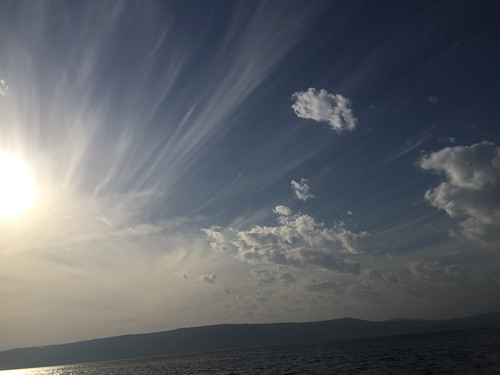Sun, light. Coffee, freshly squeezed juice. Birds, flowers. Warmth, calm. What could make a morning better? Only a drive along the Sea of Galilee to an area where Christ delivered his Sermon on the Mount--the Mount of Beatitudes. We were the first tour group to arrive and the quiet, stillness, and spring air soothed my spirit and massaged my soul. Wow--could've set up camp there indefinitely. Such peace. Such quiet. Such grace.

Then a drive north--the jet skis on the sea reminding me that this is a modern sea, a modern country with a history so rich, so filled with passion and so filled with issues--political and otherwise. Water, for instance. The water crisis throughout the area has been addressed for decades. No watering lawns during heat of the day, no washing vehicles with a running hose. Finally desaltinization and the hope that in three years the crisis mode will be over. Providing drinking water to Jordan, guarding water sources from the Syria-issues over water--for without it, there is no chance of life. Their daily struggle here reminds me of how at home I run the water while brushing my teeth, linger in the shower while soothing muscles, water the lawn during dry spells, hoping to green up the lawn.

This area is filled with the history of recent as well as past wars. Religion and history are obvioiusly not mutually exclusive. This valley (the Jordan), with Lebanon and Syria just across the hills, was under seige for 19 years, and those growing up here from 1948-1967 lived and were educated in bomb shelters in the area. The memory of 1967 and the 80s is still vivid. Escape paths for Jews into Israel from Lebanon ran past the River Dan and we saw Israeli tanks and bunkers left as relics in the countryside.

Springs feed into four rivers, the Bareighit, the Hasbany, the Laddan, and the Banias, which form the headwaters of the Jordan River. These waters are the essence of life to Israel. Our guide showed us a burbling brook, part of the River Dan, and said, "To you this may just be a stream, but to us it is the world."


Next stop wasn't far--Caesarea Philipi is the sight where the Apostle Peter proclaimed or confessed that he knew Jesus was the true son of God. What makes this declaration so unique is that Peter gave this declaration in the midst of an area that contained one of the six gates of hell (a cave), altars to gods, and a temple built to honor the god Pan. The altars were carved into the rock with ledges that held the icons of each god. His disregarding the false gods in this settting is considered remarkable.

We climbed into the Golan Heights, which is the area that runs along the east side of the Sea of Galilee (I was trying to disregard all thoughts of the new security alert I'd received from the US Embassy in Tel Aviv before we left about travel in this area) and bunkers from the '67 war were tossed in among the stones in the fields and the trees on the ridges. They seemed to naturally blend in, but honestly, can war and its relics ever blend into the landscape? Aren't they really a scab that might fester?
Back to the Sea of Galilee and Capernaum. Here one finds archeological and scientific evidence that aligns with scripture. The remains of the house of Peter's mother (where Jesus lived for two years) and a synagogue also from his time are visible, the black volcanic rock of that era unearthed from the structures built upon them. Our guide shared that originally synagogues were not houses of prayer as they are today. In Jesus' time they were gathering areas for study, discussion, etc. But after the destruction of the temple in Jerusalem 70-90 AD, the Book of Prayer was written, no more sacrifices were offered, and synagogues became houses of prayer and worship.


The sun and warm breeze greeted us on our boatride on the Sea of Galilee, really a large lake about 14 miles long and 7 miles wide. The captain showed us how nets were cast and we spent a special hour experiencing the water, the sky, the mystery of this magical body of water.

I'd always heard of the Sea of Galilee and the Jordan River, and today I got to touch both. A favorite baptismal site (rumored to be near where Jesus was baptised) offers believers a chance to be baptized in the Jordan River. They rent white tunics and submerge. I rented nothing and "baptized" my feet, enjoying the coolness of the water as it found its way under my feet and between my toes. We smiled at the brown smudges we could see in the turquoise-green water--these were catfish, which are not eaten by Jews, since doing so would break the law of eating only fish who have scales. We heard from the captain of the boat that the catfish are taking over and from what we saw, he may be right.
On to Jerusalem tomorrow. This has been my favorite day so far--perhaps because the sun shone so brightly even my feet got a bit of color. Check out my ankles! Glorious.
 f us is an island unto himself or herself.
f us is an island unto himself or herself.




































































































